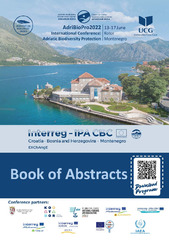Приказ основних података о документу
Still eels in Serbia?
| dc.creator | Smederevac-Lalić, Marija | |
| dc.creator | Skorić, Stefan | |
| dc.creator | Nikolić, Dušan | |
| dc.creator | Cvijanović, Gorčin | |
| dc.creator | Jaćimović, Milica | |
| dc.creator | Hegedis, Aleksandar | |
| dc.date.accessioned | 2023-12-05T11:45:35Z | |
| dc.date.available | 2023-12-05T11:45:35Z | |
| dc.date.issued | 2022 | |
| dc.identifier.isbn | 978-9940-9613-3-6 | |
| dc.identifier.uri | http://rimsi.imsi.bg.ac.rs/handle/123456789/2669 | |
| dc.description.abstract | The European eel (Anguilla anguilla), a catadromous, critically endangered species, was the subject of this study. The main goal was to determine the status of populations of European eel in the waters of the Republic of Serbia. The research included both fieldwork (27 sampling sites) and the literature data analysis for all three river basins in Serbia: Aegean, Adriatic, and Black Sea. The methodology of data collection and determination of European eel presence differed from basin to basin. The fish were identified, measured, noted and immediately returned to the water. The waters that belong to the Aegean basin in Serbia could not be considered anymore as a natural habitat for the European eel, although it inhabits the middle and lower reaches of the rivers that belong in Bulgaria, Greece and North Macedonia. The rivers of the Adriatic basin were not available for sampling; therefore, just literature data were collected. Insufficient literature data on the presence of European eels in waters of the Black Sea basin in the last decade imposed using of inquiry survey with commercial fishermen about occurrence of European eels in their catches. Total of 54 commercial fishermen were surveyed at 31 locations on the Danube, Sava and Tisza. Results showed presence of both silver and yellow stages. The survey showed that there is a linkage between the time and manner of occurrence of the life stages. The collected data were georeferenced and the area where European eels were recorded was defined. Based on the hypothetical projection, according to statistical data, annual catch reached 1352 kg in the Danube, Sava and Tisza. Recent data (2015 to 2019) are predominantly related to the Danube, which can be correlated to the connection between the Black and North Seas (Rhine-Main-Danube canal connection). This study shows that the appearance of the juvenile migration stages of European eels is not unimportant and deserves more research attention. | sr |
| dc.language.iso | en | sr |
| dc.publisher | Institute of Marine Biology, University of Montenegro | sr |
| dc.relation | info:eu-repo/grantAgreement/MESTD/inst-2020/200053/RS// | sr |
| dc.rights | openAccess | sr |
| dc.source | International Conference Adriatic Biodiversity Protection - AdriBioPro2022 | sr |
| dc.subject | eel/ migration/ Danube | sr |
| dc.title | Still eels in Serbia? | sr |
| dc.type | conferenceObject | sr |
| dc.rights.license | ARR | sr |
| dc.citation.spage | 85 | |
| dc.identifier.fulltext | http://rimsi.imsi.bg.ac.rs/bitstream/id/6963/bitstream_6963.pdf | |
| dc.identifier.rcub | https://hdl.handle.net/21.15107/rcub_rimsi_2669 | |
| dc.type.version | publishedVersion | sr |

